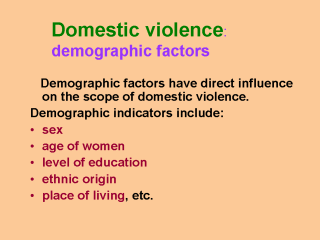| front |1 |2 |3 |4 |5 |6 |7 |8 |9 |10 |11 |12 |13 |14 |15 |16 |17 |18 |19 |20 |21 |22 |23 |24 |review |
 |
Age of woman: the older the woman the more likely she will be exposed to domestic violence
committed by husband Ethnic origin: Violence committed against women in the family is more common to Kazakh and other Asian families (Uzbek, Tatar, Uigur, etc.) as compared to European ethic groups (Russians, Ukrainians, Germans, etc.) Level of education: the higher a woman’s level of education, the less likely she will be exposed to violence. This feature is exemplified by the indicator of secondary education. Over half of the women surveyed with incomplete secondary education report having suffered from domestic violence. At the same time the number of women with incomplete secondary education does not exceed 30%. Social and professional status: the higher a woman’s social and professional status, the smaller the risk of her being exposed to domestic violence. There is one exception – businesswomen – whose status is normally considered to be high. However, she is comparatively often exposed to violence. This is a glaring contradiction. However, businesswomen are often small traders/market women who are economically forced to undertake such activity due to small incomes. Area of living: Violence against women is wider spread in rural areas than in urban areas. Regional aspect: The prevalence of domestic violence can be ordered by region in decreasing prevalence as follows: Southern, Almaty, Western, Northern, Central, Eastern. See the table: Influence of demographic factors on domestic violence |